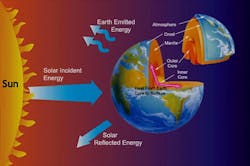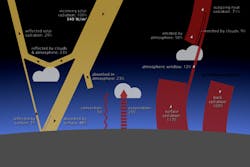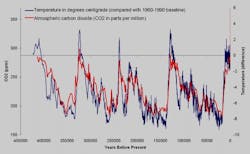Earth rotates as it travels around the sun, and if there was no atmosphere, its surface facing the sun would be hot and the other would be cold. The conditions would be the same as on the moon, where the surface facing the sun reaches more than 100 °C, while the other side cools to about -150 °C during the lunar night. It’s our atmosphere that protects our planet from such a temperature cycle because it absorbs some of the solar heat during the day and transmits some of that heat back to the planet's surface during the night. It is, in effect, providing thermal insulation to Earth.
The average temperature of Earth's surface during the pre-industrial period of 1880-1900 was 13.9 °C. By 2022, it had increased to 14.97 °C and is still rising. The media usually reports the present value of global warming as 1.1 °C. However, the zero reference of these reports isn’t always between 1880 and 1900. Also, it’s not usually, clearly stated from what segment of the planet's surface the measurements were collected.
It should always be the area between the latitudes 45° N to 90° N in the northern hemisphere. To illustrate this, the zero reference for the data in Figure 3 is the average temperature for the period between 1960 and 1990, and it’s between 1951 to 1980 in Figure 4. In Figure 3, the blue lines show global temperature and the red lines show atmospheric CO2 concentration during the last half-million years.
We can see that during the last half-million years Earth's average global temperature cycled between 3 °C and -10 °C as the distance between its surface and the sun cycled. The time periods between major ice ages were somewhat more than 100,000 years. During that period, the temperature decreased about 1 °C per 10,000 years. It has since risen about 1 °C per 1,000 years. The last ice age ended about 12,000 years ago, so during the last half million years, Earth's temperature never rose above 3 °C or dropped below -10 °C.
What does this tell us about the heat balance of our planet? It tells us that global temperature follows the cyclic change in its distance to the sun. It also tells us that this effect is amplified by the variation in the highly reflective ice cover of the planet. That’s because, as the area of the ice cover drops, heat absorption rises, and global temperature rises as well.
The quantity of solar heat reflected into outer space is dropping because of the melting of the ice, which reflects much more heat than does either land or water (Figure 5, above). This self-accelerating process can, not only bring global warming to the tipping point, but also be reversed by "whitening the human footprint by using lighter colored roofs, roads, agriculture, etc.
The accurate measurement of both the yearly rise of global warming that amounts to only 0.02 °C/year or the detection of global temperatures over past millennia requires outstanding technology. For more on such technology, see my previous column, “Can we reliably measure the rate of rise of global warming at 0.01 °C/year” in Control, May 2020.About the Author

Leaders relevant to this article:




